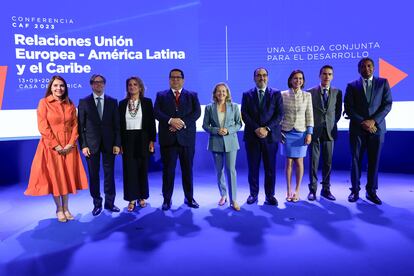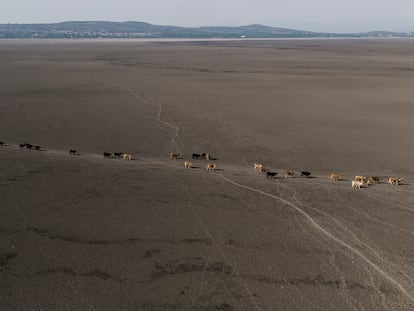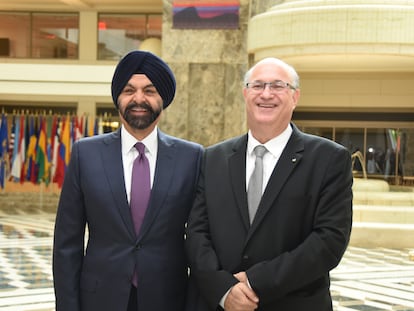Spain serves as a bridge between Latin America and the EU, as representatives from both regions meet to address common challenges
The president of CAF-Development Bank of Latin America and the Caribbean, Sergio Díaz-Granados, believes that this week’s upcoming meeting of government officials from both blocs ‘will be an opportunity of historic significance’

On Wednesday, Spain’s First Vice President Nadia Calviño emphasized that country’s role in strengthening relations between the European Union and Latin America, which she defined as strategic. “Spain has a key role to play as a bridge between these two continents,” she declared at an event held at the Casa de América in Madrid. Organized by CAF-Development Bank of Latin America and the Caribbean, the event served to analyze some of the common challenges that the two regions face in three major areas: the transition to green energy, digital transformation and human development.
Just a couple of days before the informal meeting that will be held for the first time by EU ministers of economy and finance and the Community of Latin American and Caribbean States (CELAC) in Santiago de Compostela, Spain, Calviño called for strengthening ties between the two regions in a particularly turbulent environment. “In recent years, we have seen it all: the pandemic, a war on Europe’s doorstep… [and] now we are seeing natural disasters that overwhelm all of us around the world… Amid the global challenges of geopolitical tensions [and] trade fragmentation, I believe that a commitment to multilateralism and cooperation is particularly important,” she said.
CAF’s president, Sergio Díaz-Granados, who promoted this meeting of ministers from both blocs, is confident that “it will be an opportunity of historic significance.” He called for concrete results that take advantage of last July’s announcement by the President of the European Commission, Ursula von der Leyen, that €45 billion ($48,339,765,000) will be made available to Latin America in financing plans through the Global Gateway tool.
In the same vein, Calviño said that, unlike other meetings where good intentions and “blah, blah, blah” prevail, this one — which was organized under the auspices of the Council of the EU, where Spain currently occupies the presidency — features substantive discussion and a list of strategic projects that will be followed through on. The Minister of Economy noted that trade between the two regions has increased by 40% in 10 years, and together they comprise 60 countries representing 14% of the world’s population and 21% of global GDP.
Speakers frequently noted that Latin America has much to contribute. “For many years, it has been seen as a region that is a source of problems in the world, but it is also important to convey the message that it offers many solutions to the world’s problems, particularly with respect to energy transition, which will draw heavily on goods produced in Latin America,” said Alex Contreras, Peru’s Minister of Economy and Finance and President of CAF’s Board of Directors.
Although the region is rich in the metals needed to manufacture batteries for electric cars, like cobalt, nickel and lithium, Latin America seeks to go beyond being a mere supplier of raw materials, as Mauricio Cárdenas, professor of Global Leadership at Columbia University’s School of International and Public Affairs and Colombia’s former minister of finance, explained in one of the panels. “We do not want to repeat the cycle of supplying raw materials and having a new process of deindustrialization. We must not repeat the experience of selling low-value-added products. The agreements must be based on creating added value and inserting Latin America into electric car production value chains.”
More vulnerable to climate change
Cárdenas observed that the region is particularly vulnerable to the effects of climate change because its average temperature is higher than Europe’s, which increases the risk of natural disasters. In addition, Latin America has less of an ability to adapt, partly because its access to financing entails paying higher interest rates, since countries in the region are perceived as higher risk, despite the fact that, on average, they are less indebted than those in Europe. These high interest rates make it more difficult to move forward with projects to tackle climate change.
Spain’s Third Vice-President and Minister for Ecological Transition and the Demographic Challenge, Teresa Ribera, warned of the economic consequences of climate change in her speech. “Does anyone think that the floods in Greece and Libya don’t impact the population and productive sectors? Does anyone think that the impact is the same for all citizens? Does anyone think that 32 degrees C [89.6 degrees F] in Buenos Aires in winter is normal? Or that prolonged droughts are conducive to food security?”
Some of the planned roundtable discussion topics included green hydrogen as a new supply source, liquefied natural gas as a transitional energy and joint efforts to reduce deforestation. There was also discussion of success stories, such as the Argentine region of Misiones, which has native forests in more than half of its territory. Minister of Economy and Finance, Azucena Arbeleche, shared Uruguay’s own success on that front. “A significant percentage of electric energy, 93%, comes from renewable energies. And if we look at wind power, our situation is similar to Portugal, Denmark and Ireland,” she said.
Colombia wants to ride that wave as well. The country’s Minister of Finance and Public Credit Ricardo Bonilla highlighted Colombia’s wind and solar potential in some desert areas. He observed that they need to reindustrialize by replacing facilities for the assembly of combustion engine vehicles with electric ones.
Youth and technological growth
Enrique Riquelme, CEO of Cox Energy Group, which has a strong presence in Latin America, argued that the region’s draws include its youth, with an average age under 30, and its growing demand for energy. Gustavo Beliz — Argentina’s former Secretary of Strategic Affairs — also included the growth of startups whose valuation exceeds 1 billion as another benefit. These have gone from five in 2018 to 34 in 2022. Among the region’s shortcomings, he notds that Latin America needs to train 700,000 experts in cybersecurity and biosecurity, as well as grow in high-tech sectors such as semiconductors and quantum computing.
Spain’s Secretary of State for Digitalization and Artificial Intelligence, Carme Artigas, asserted that “digitalization is a great tool for regional structuring and should serve as a dike to contain inequality.” Max Trejo, Secretary General of the International Youth Organization, concurred, adding that Latin American youth “must move from being consumers of technology to producers [of it],” which will necessitate greater training in digital skills.
Trinidad Jiménez, Telefónica’s Director of Global Public Affairs Strategy, praised Latin America’s digital infrastructure but said that new facilities still need to be deployed, which translates into multimillion-dollar investments. “Between 2023 and 2030 it is going to require over $100 billion [for] digital infrastructure,” she said. To that end, Jiménez called for an appropriate regulatory framework for investors and closer public-private collaboration.
Sign up for our weekly newsletter to get more English-language news coverage from EL PAÍS USA Edition
Tu suscripción se está usando en otro dispositivo
¿Quieres añadir otro usuario a tu suscripción?
Si continúas leyendo en este dispositivo, no se podrá leer en el otro.
FlechaTu suscripción se está usando en otro dispositivo y solo puedes acceder a EL PAÍS desde un dispositivo a la vez.
Si quieres compartir tu cuenta, cambia tu suscripción a la modalidad Premium, así podrás añadir otro usuario. Cada uno accederá con su propia cuenta de email, lo que os permitirá personalizar vuestra experiencia en EL PAÍS.
¿Tienes una suscripción de empresa? Accede aquí para contratar más cuentas.
En el caso de no saber quién está usando tu cuenta, te recomendamos cambiar tu contraseña aquí.
Si decides continuar compartiendo tu cuenta, este mensaje se mostrará en tu dispositivo y en el de la otra persona que está usando tu cuenta de forma indefinida, afectando a tu experiencia de lectura. Puedes consultar aquí los términos y condiciones de la suscripción digital.
More information
Archived In
Últimas noticias
Most viewed
- Reinhard Genzel, Nobel laureate in physics: ‘One-minute videos will never give you the truth’
- Oona Chaplin: ‘I told James Cameron that I was living in a treehouse and starting a permaculture project with a friend’
- Pablo Escobar’s hippos: A serious environmental problem, 40 years on
- Why we lost the habit of sleeping in two segments and how that changed our sense of time
- Chevy Chase, the beloved comedian who was a monster off camera: ‘Not everyone hated him, just the people who’ve worked with him’











































